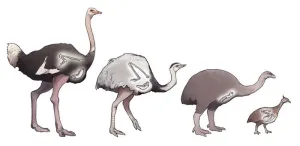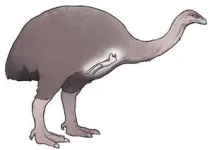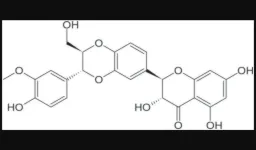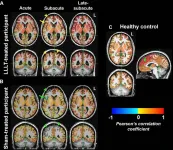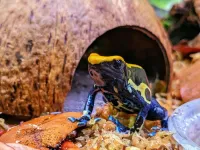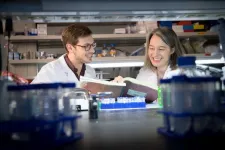(Press-News.org) Using ancient DNA extracted from the toe bone of a museum specimen, Harvard biologists have sequenced the genome of an extinct, flightless bird called the little bush moa, shedding light into an unknown corner of avian genetic history.
Published in Science Advances, the work is the first complete genetic map of the turkey-sized bird whose distant living cousins include the ostrich, emu, and kiwi. It is one of nine known species of moa, all extinct for the last 700 years, that inhabited New Zealand before the late 1200s and the arrival of Polynesian human settlers.
“We’re pulling away the veil across the mystery of this species,” said senior author Scott V. Edwards, professor in the Department of Organismic and Evolutionary Biology and curator of ornithology at the Museum of Comparative Zoology. “We can study modern birds by looking at them and their behavior. With extinct species, we have very little information except what their bones looked like and in some cases what they ate. DNA provides a really exciting window into the natural history of extinct species like the little bush moa.”
Bush moa were the smallest of the moa species, weighing about 60 pounds and distributed in lowland forests across the north and south islands of New Zealand. Genomic analysis has revealed their closest living relatives aren’t kiwis, as was originally speculated, but rather tinamous, a Neotropical bird group from which they diverged genetically about 53 million years ago.
The Harvard team offers new genetic evidence for various aspects of bush moa sensory biology. Like many birds, they had four types of cone photoreceptors in their retinas, which gave them not only color but also ultraviolet vision. They had a full set of taste receptors, including bitter and umami. Perhaps the most remarkable trait of these flightless birds is their complete absence of forelimb skeletal elements that typically comprise birds’ wings, the researchers wrote. Studying the moa genome could offer new clues into how and why some birds evolved to become flightless.
The scientists used high-throughput DNA sequencing, which allows rapid sequencing of short DNA fragments of only 101 nucleotide base pairs and the building of libraries with millions of these genetic sections. To produce the bush moa genome, the team sequenced the equivalent of 140 bird genomes, or about 140 billion base pairs of DNA, only about 12% of which was actual moa DNA (the rest was bacterial).
They then assembled the genome, taking each snippet of DNA and mapping it to its correct position. Genome assembly of extinct species is painstaking work that is made more accessible through technologies like high-throughput sequencing. Other species that have been mapped similarly are the passenger pigeon, the woolly mammoth, and our close relative, the Neanderthal. Using an existing emu genome as a guide, they strung together the bush moa’s genetic sequence by finding overlaps between each genetic snippet, essentially reconstructing a long puzzle of 140 billion pieces.
The bush moa project originated more than 15 years ago in the lab of the late Allan J. Baker, an expert in ancient bird DNA at the Royal Ontario Museum who first extracted and sequenced the bird’s DNA from a fossil recovered on the South Island of New Zealand. Also involved in the initial DNA processing and sequencing was co-author Alison Cloutier, who formerly worked with Baker and later became a postdoctoral researcher in Edwards’ lab at Harvard which inherited the data.
Reconstructing the genome of a long-extinct bird fills in a new branch of the avian family tree, opening doors to study avian evolution, or even someday, to possibly resurrect these species through de-extinction technologies.
“To me, this work is all about fleshing out the natural history of this amazing species,” Edwards said.
END
Bringing back an ancient bird
Scientists sequence complete genome of the extinct bush moa
2024-05-28
ELSE PRESS RELEASES FROM THIS DATE:
Wistar research identifies mechanisms for selective multiple sclerosis treatment strategy
2024-05-28
PHILADELPHIA — (May 28, 2024) — The Wistar Institute’s Paul M. Lieberman, Ph.D., and lab team led by senior staff scientist and first author, Samantha Soldan, Ph.D., have demonstrated how B cells infected with the Epstein-Barr virus (EBV) can contribute to a pathogenic, inflammatory phenotype that contributes to multiple sclerosis (MS); the group has also shown how these problematic B cells can be selectively targeted in a way that reduces the damaging autoimmune response of multiple sclerosis. The lab’s findings were published in Nature Microbiology in the paper, “Multiple sclerosis patient derived spontaneous B cells have distinct EBV and ...
Fatherhood’s hidden heart health toll
2024-05-28
Among fathers, heart health was worse for men who became fathers under the age 25
First U.S. multiethnic longitudinal study to analyze cardiovascular health outcomes of fathers
Results differed by race and ethnicity subgroups
Age-adjusted rate of death for Black fathers was lower than for nonfathers
‘Fatherhood may be protective for Black men’
CHICAGO --- Heart disease is the leading cause of death among men, and being a father may put men at an even greater risk of poor heart health later in life, reports a new study from scientists at Northwestern University and Ann & ...
The importance of integrated therapies on cancer: Silibinin, an old and new molecule
2024-05-28
“This consideration could be the starting point to study whether Silibinin could contrast tumor progression, aging and inflammaging through molecular and cellular mechanisms [...].”
BUFFALO, NY- May 28, 2024 – A new review paper was published in Oncotarget's Volume 15 on May 23, 2024, entitled, “The importance of integrated therapies on cancer: Silibinin, an old and new molecule.”
In this new review, researchers Elisa Roca, Giuseppe Colloca, Fiorella Lombardo, Andrea Bellieni, Alessandra Cucinella, Giorgio Madonia, Licia Martinelli, Maria Elisa Damiani, Ilaria Zampieri, and ...
Texas A&M-led team creates first global map of seafloor biodiversity activity
2024-05-28
A pioneering study has used extensive global datasets and machine learning to map the activities of seafloor invertebrate animals, including worms, clams and shrimps, across the entire ocean, revealing for the first time critical factors that support and maintain the health of marine ecosystems.
The international team, led by Texas A&M University and including investigators from Yale University and the University of Southampton, specifically focused on the unsung yet vital role burrowing animals play as "ecosystem engineers" in shaping nutrient ...
Light therapy increases brain connectivity following injury
2024-05-28
OAK BROOK, Ill. – Low-level light therapy appears to affect healing in the brains of people who suffered significant brain injuries, according to a study published today in Radiology, a journal of the Radiological Society of North America (RSNA).
Lights of different wavelengths have been studied for years for their wound-healing properties. Researchers at Massachusetts General Hospital (MGH) conducted low-level light therapy on 38 patients who had suffered moderate traumatic brain injury, an injury to the head serious enough to alter cognition and/or be visible on a brain scan. Patients received ...
Power imbalance in health care reveals impact of race and role on team dynamics and DEI efforts
2024-05-28
Background and Goal: Team-based care is considered the gold standard in delivery models. It uses integrated clinical teams with diverse skills and perspectives to provide efficient, high-quality health care services. Within these teams, individuals from minoritized racial-ethnic groups, often referred to as persons of color (POC), typically occupy roles with less authority (e.g., medical assistants), while white individuals more frequently hold positions of greater power (e.g., physicians). Few studies have explored the viewpoints of staff members in lower-power roles, who are disproportionately POC and constitute the majority of a health care team. This study aims to ...
NRG Oncology appoints new vice-chairs for their patient advocate committee
2024-05-28
NRG Oncology (NRG), a National Cancer Institute (NCI) National Clinical Trials Network (NCTN) group focused on improving outcomes for adults with cancer through multi-center clinical research, recently announced two new Vice-Chairs to co-lead the NRG Patient Advocate Committee (PAC) alongside the current PAC Committee Chair, Dorothy Erlanger.
Marlyn Molero, was appointed as Vice-Chair of the NRG PAC. Marlyn is a clinical researcher in the oncology area with Commonspirit Research Institute as well as a Spanish interpreter at Vituity. Marlyn brings a unique perspective to the NRG PAC leadership ...
Why do Dyeing poison frogs tap dance?
2024-05-28
The toe tapping behavior of various amphibians has long attracted attention from researchers and pet owners. Despite being widely documented, the underlying functional role is poorly understood. In a new paper, researchers demonstrate that Dyeing poison frogs modulate their taps based on specific stimuli.
Dyeing poison frogs, Dendrobates tinctorius, have been shown to tap their posterior toes in response to a range of prey sizes, from small fruit flies to large crickets. In the present study, ...
UC Irvine study reveals circadian clock can be leveraged to enhance cancer immunotherapy
2024-05-28
Irvine, Calif., May 28, 2024 — A multidisciplinary research team at the University of California, Irvine has revealed that the circadian clock – the biological pacemaker that governs daily rhythms in physiological processes, including immune functions – can be leveraged to enhance the efficacy of checkpoint inhibitor cancer therapy. Checkpoint inhibitors block different proteins from binding to tumor cells, allowing the immune system’s T cells to kill the tumor.
The study, published online ...
Cell-targeting technology allows researchers to isolate neuronal subpopulations and link them to behavioral states
2024-05-28
(MEMPHIS, Tenn. – May 27, 2024) As gene sequencing technologies become more powerful, our understanding of cellular diversity has grown in parallel. This led scientists at St. Jude Children’s Research Hospital to create a tool to improve the ease and accuracy with which investigators can study specific subpopulations of cells. The tool, named Conditional Viral Expression by Ribozyme Guided Degradation (ConVERGD), allows researchers to specifically access these subgroups of cells and precisely manipulate ...
LAST 30 PRESS RELEASES:
Autistic and non-autistic faces may “speak a different language” when expressing emotion
No clear evidence that cannabis-based medicines relieve chronic nerve pain
Pioneering second-order nonlinear vibrational nanoscopy for interfacial molecular systems beyond the diffraction limit
Bottleneck in hydrogen distribution jeopardises billions in clean energy
Lung cancer death rates among women in Europe are finally levelling off
Scientists trace microplastics in fertilizer from fields to the beach
The Lancet Obstetrics, Gynecology, & Women’s Health: Taking paracetamol during pregnancy does not increase risk of autism, ADHD or intellectual disabilities, confirms new gold-standard evidence review
Taking paracetamol during pregnancy does not increase risk of autism, ADHD or intellectual disabilities
Harm reduction vending machines in New York State expand access to overdose treatment and drug test strips, UB studies confirm
University of Phoenix releases white paper on Credit for Prior Learning as a catalyst for internal mobility and retention
Canada losing track of salmon health as climate and industrial threats mount
Molecular sieve-confined Pt-FeOx catalysts achieve highly efficient reversible hydrogen cycle of methylcyclohexane-toluene
Investment in farm productivity tools key to reducing greenhouse gas
New review highlights electrochemical pathways to recover uranium from wastewater and seawater
Hidden pollutants in shale gas development raise environmental concerns, new review finds
Discarded cigarette butts transformed into high performance energy storage materials
Researchers highlight role of alternative RNA splicing in schizophrenia
NTU Singapore scientists find new way to disarm antibiotic-resistant bacteria and restore healing in chronic wounds
Research suggests nationwide racial bias in media reporting on gun violence
Revealing the cell’s nanocourier at work
Health impacts of nursing home staffing
Public views about opioid overdose and people with opioid use disorder
Age-related changes in sperm DNA may play a role in autism risk
Ambitious model fails to explain near-death experiences, experts say
Multifaceted effects of inward foreign direct investment on new venture creation
Exploring mutations that spontaneously switch on a key brain cell receptor
Two-step genome editing enables the creation of full-length humanized mouse models
Pusan National University researchers develop light-activated tissue adhesive patch for rapid, watertight neurosurgical sealing
Study finds so-called super agers tend to have at least two key genetic advantages
Brain stimulation device cleared for ADHD in the US is overall safe but ineffective
[Press-News.org] Bringing back an ancient birdScientists sequence complete genome of the extinct bush moa
